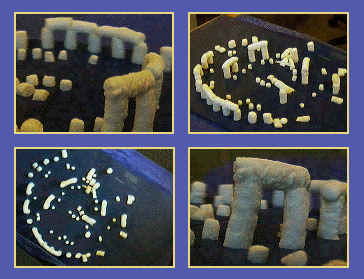Foamhenge
Like Stonehenge, but made with packing foam!
The Celts are known for their stonework. Standing stones -- carved or plain, alone or in formation -- characterize Celtic civilizations. Stonehenge is frequently associated with the Celts, or, more specifically, with the Celtic priestly caste of Druids. However, if the Druids worshiped at Stonehenge, it was without knowledge of the site's origins or purpose, for Stonehenge was completed 1500 years before the Celts arrived in Britain. Indeed, when the Celts arrived in the British Isles, they probably regarded Stonehenge with the same mystery and wonder that modern visitors feel.
Stonehenge was built in three stages beginning in 2800 B.C. and ending about 2000 B.C. It represented the highest achievement of human technology at the time. About four thousand years later, human technology brought us Eco-Foam, a biodegradable substitute for styrofoam packing material. Eco-Foam is made by forcing air through a paste derived from corn which produces small cylinders similar to the commonly-used styrofoam packing peanuts. When the Eco-Foam is exposed to water, it instantly dissolves, leaving little trace.
In 1994, a small team of software engineers at a consulting company in Cleveland, Ohio discovered that Eco-Foam does not dissolve when it is only slightly dampened. The part of the foam that comes in contact with the moisture becomes tacky, and this property can be used to stick Eco-Foam peanuts together or to other objects. The natural consequence of this discovery was to build a scale model of Stonehenge.

Thus, Foamhenge was born. Foamhenge was built under the direction of Drew, who meticulously researched the layout of the actual site. Its construction took place over a three day period -- approximately 100,000 times faster than the construction of the real Stonehenge. Unfortunately, it has also decayed much faster than the real thing. The cumulative effects of humidity and transportation have reduced the once proud replica to a set of blobs on a blue folder vaguely reminiscent of the plastic vomit available in novelty stores.
Fortunately, Foamhenge has been preserved on videotape in all its grandeur, and the images you see here are taken from the QuickTime moovies produced from that tape.
Be sure to check out my Celtic Bibliography for pointers to more information about Stonehenge.

